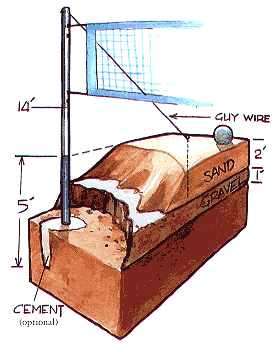| Ok...So you have the shits with having
to wait around in the sand at Manly for a game. The big boys are training
on the top court and social comp is being run on the other 4. Here's
what to do, dig up your backyard and build your own sand court. Even
better yet dig up your mates backyard.
Building a proper sand court is a little more difficult than expanding
your yonger brothers sandbox from pint-sized proportions to court-side
dimensions.
If not done correctly you'll be more concerned about quicksand
and flooding than quick sets and float serves. And as abundant as
it is at the beach, sand is not so common a commodity for you flat
landers (especially the soft stuff you want to dive on), and it'll
cost you.
1) The
playing area consists of the court and a space around it measuring
three meters (nine feet, 10 inches) in each direction. The space
above the playing area should be free of obstructions. The playing
area should be level and consist of good quality sand to a thickness
which prevents players from contracting and underlying hard surface.
 2)
Dimensions of the court are 16 meters by eight meters and are measured
from the outer edge of the boundary lines. The boundary lines should
be made of brightly colored rope or material having similar characteristics
(ropes can sometimes leave burns if you contact them accidently,
thick nylon tape is what the professionals use). The boundary lines
should not unreasonably impede play. 2)
Dimensions of the court are 16 meters by eight meters and are measured
from the outer edge of the boundary lines. The boundary lines should
be made of brightly colored rope or material having similar characteristics
(ropes can sometimes leave burns if you contact them accidently,
thick nylon tape is what the professionals use). The boundary lines
should not unreasonably impede play.
3) The plane of the
net serves as an invisible center line of the court, dividing it
into two halves.
4) Net
supporters should be made of wood, metal, thick PVC, or other material
that will withstand tension and not bend or break when stressed.
Supports should be approximately 4 - 5 meters long and buried at
least five feet deep ( but if Carl G got his way they woud be
10 meters deep and you would need a truck to get them in) .
They need not be cemented in place. Supports should be free of hazardous
portrusions. If you use guy wires, they should be made of bright
colors or padded to prevent injury to players. All anchors for guy
wires and boundary lines should be buried at least 6-8 inches under
the surface of the sand and free of sharp edges.
5) The
court area should be excavated to a three-foot depth with a drainage
ditch leading away from the lowest point of the court. Perforated
drainage pipe should be laid in a zig-zag pattern over the base
of the area with one end capped and the other open to the drainage
ditch. Proper drainage is extremely important, or you could find
yourself playing in a swamp. (Even if the court is built above ground,
sand will still retain water!)
6) Overlay
the court area with a one-foot thickness of #57, or similar type,
gravel. Above the gravel place burlap or some other screen-type
cover to prevent sand from washing through onto the base. Deposit
one-to-two feet of washed plaster (golf course or soft and fluffy
horse sand is also acceptable) over the area and rake level. (When
testing sand for purchase wear shorts and test the sand in both
dry and wet conditions by diving onto it knees first, "no scrapes,
no problem," scrapes, scrap it and keep shopping.) Economics
may dictate the depth of sand used but keep in mind you'll be needing
your friends to choose your place over the beach so the better your
sand the better. Assuming the gravel base is in place, and you don't
mind raking back the middle of the "dished court" from
the sides every week, one foot of sand should be sufficient.
Sand is not cheap,and i have no idea how much it costs, but it's
a lot. The playing area alone will consume approximately 100 tons
of sand at a depth of only one foot. The formula for determining
the number of tons of sand needed is: tons of sand = L x W x D divided
by 27 x 1.5 (where L, W, and D are in feet).
7) Competition
netting is nine-and-a-half meters (32 feet) long and one meter (39
inches) wide. The proper height for a men's net is 7' 11-5/8"
(2.43 meters) tall and for women it's 7' 4-1/8" (2.24 meters)
tall. The body of the net should be made of 10-centimeters (4 inches)
square mesh and have trim doubled over to secure the mesh to the
top and bottom cables. The cables may be either rope or aircraft
cable. Net height is measured from the center of the court, at which
point the net should be within .7 centimeters (one quarter inch)
of the proper height.
|








 2)
Dimensions of the court are 16 meters by eight meters and are measured
from the outer edge of the boundary lines. The boundary lines should
be made of brightly colored rope or material having similar characteristics
(ropes can sometimes leave burns if you contact them accidently,
thick nylon tape is what the professionals use). The boundary lines
should not unreasonably impede play.
2)
Dimensions of the court are 16 meters by eight meters and are measured
from the outer edge of the boundary lines. The boundary lines should
be made of brightly colored rope or material having similar characteristics
(ropes can sometimes leave burns if you contact them accidently,
thick nylon tape is what the professionals use). The boundary lines
should not unreasonably impede play.